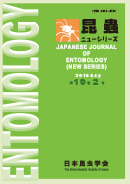Volume 19, Issue 2
Displaying 1-16 of 16 articles from this issue
- |<
- <
- 1
- >
- >|
-
2016 Volume 19 Issue 2 Pages Cover1-
Published: April 05, 2016
Released on J-STAGE: April 25, 2019
Download PDF (878K) -
2016 Volume 19 Issue 2 Pages i-iv
Published: April 05, 2016
Released on J-STAGE: August 26, 2020
Download PDF (27355K) -
2016 Volume 19 Issue 2 Pages App1-
Published: April 05, 2016
Released on J-STAGE: April 25, 2019
Download PDF (1442K)
-
2016 Volume 19 Issue 2 Pages 41-49
Published: April 05, 2016
Released on J-STAGE: April 25, 2019
Download PDF (1048K) -
2016 Volume 19 Issue 2 Pages 50-60
Published: April 05, 2016
Released on J-STAGE: April 25, 2019
Download PDF (655K)
-
2016 Volume 19 Issue 2 Pages 61-62
Published: April 05, 2016
Released on J-STAGE: April 25, 2019
Download PDF (247K)
-
2016 Volume 19 Issue 2 Pages 63-65
Published: April 05, 2016
Released on J-STAGE: April 25, 2019
Download PDF (1424K)
-
2016 Volume 19 Issue 2 Pages 66-69
Published: April 05, 2016
Released on J-STAGE: April 25, 2019
Download PDF (236K)
-
2016 Volume 19 Issue 2 Pages 70-73
Published: April 05, 2016
Released on J-STAGE: April 25, 2019
Download PDF (228K) -
2016 Volume 19 Issue 2 Pages 74-76
Published: April 05, 2016
Released on J-STAGE: April 25, 2019
Download PDF (116K) -
2016 Volume 19 Issue 2 Pages App2-
Published: April 05, 2016
Released on J-STAGE: April 25, 2019
Download PDF (1442K) -
2016 Volume 19 Issue 2 Pages App3-
Published: April 05, 2016
Released on J-STAGE: April 25, 2019
Download PDF (1442K) -
2016 Volume 19 Issue 2 Pages App4-
Published: April 05, 2016
Released on J-STAGE: April 25, 2019
Download PDF (1442K) -
2016 Volume 19 Issue 2 Pages App5-
Published: April 05, 2016
Released on J-STAGE: April 25, 2019
Download PDF (1442K) -
2016 Volume 19 Issue 2 Pages Cover2-
Published: April 05, 2016
Released on J-STAGE: April 25, 2019
Download PDF (878K) -
2016 Volume 19 Issue 2 Pages Cover3-
Published: April 05, 2016
Released on J-STAGE: April 25, 2019
Download PDF (878K)
- |<
- <
- 1
- >
- >|
